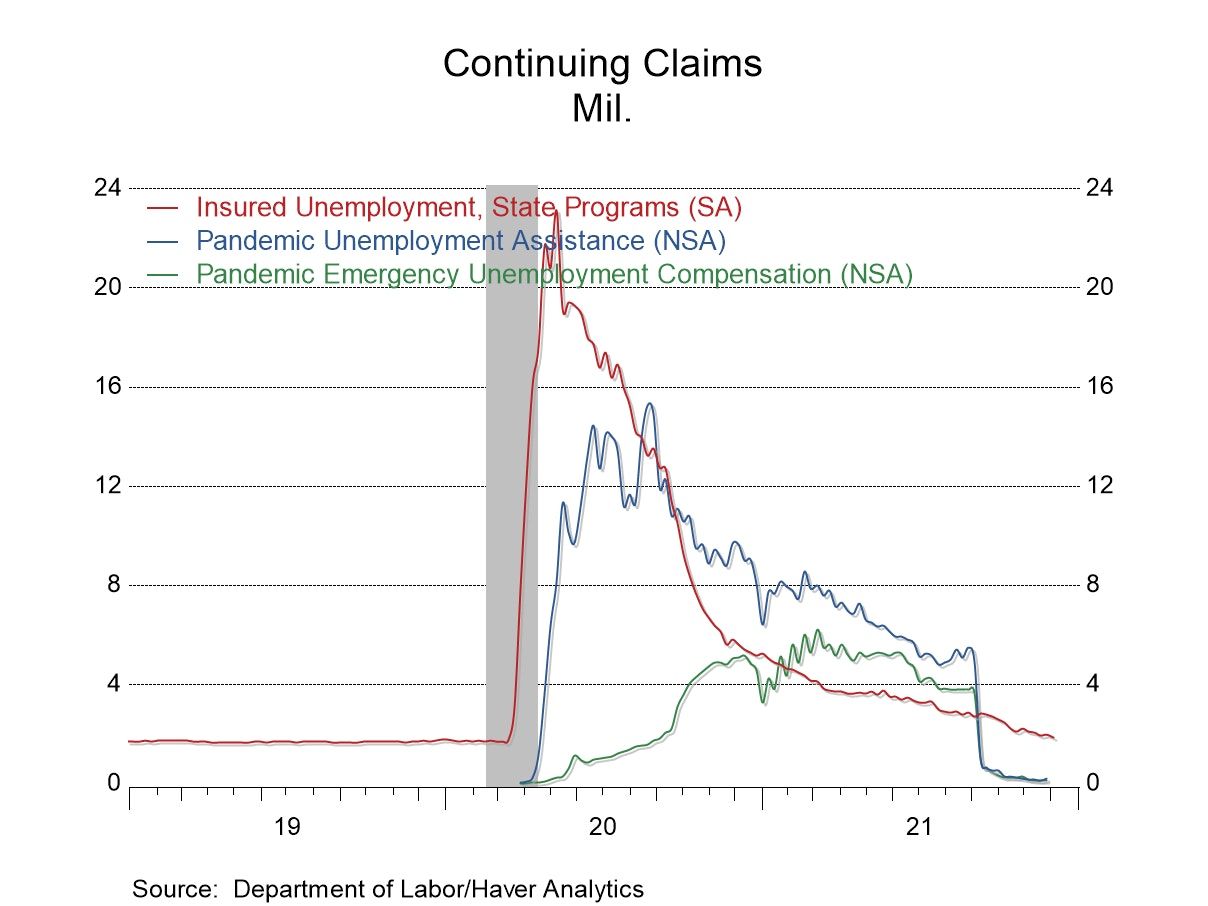U.S. Initial Unemployment Insurance Claims Rise Modestly
Summary
- Initial claims increase just 18,000 from 52-year low.
- Continuing claims in regular programs ease.
- Insured jobless rate also eases, approaches pre-pandemic level.


Initial claims for unemployment insurance rose 18,000 to 204,000 in the week ended December 11 (-76.4% y/y) from 188,000 in the prior week, revised from 184,000 reported initially. The prior week’s readings were the lowest since September 6, 1969, that is, just over 52 years ago. The Action Economics Forecast Survey expected 196,000 claims for the latest week. The 4-week moving average fell to 203,750 in the week ended December 11 from 219,750 the week before.
Initial claims for the federal Pandemic Unemployment Assistance (PUA) program in the December 11 week rose to 1,854 (-99.6% y/y) from 1,835 in the prior week. This program expired on September 4. These claims averaged 107,756 per week during August, the last full month of the program. The PUA program provided benefits to individuals who are not eligible for regular state unemployment insurance benefits, such as the self-employed. Given the brief history of this program, these and other COVID-related series are not seasonally adjusted.
Continued weeks claims for regular state unemployment insurance decreased to 1.845 million (-67.1% y/y) during the week ended December 4 from 1.999 million in the prior week, revised from 1.992 million. The insured unemployment rate fell back to 1.4% from 1.5%; just before the pandemic struck in March 2020, the rate was hovering at 1.2%.
In the week ended November 27, continued weeks claimed in the Pandemic Assistance Program (PUA) program rose to 194,189 from 124,536 (-98.0% y/y). The number of continued weeks claimed compares to 4.896 million in the last week of the program, September 4. Continued weeks claimed for Pandemic Emergency Unemployment Compensation (PEUC) increased to 136,413 in the November 27 week from 112,728 in the prior week and below the 3,644,555 claims during the last week of the program on September 4. This program covered people who had exhausted their state unemployment insurance benefits.
In the week ended November 27 the total number of all state, federal, PUA and PEUC continued claims was 2.458 million, up from 1.948 million the week before. These figures are not seasonally adjusted.
The state insured rates of unemployment in regular programs continue to vary. In the week ending November 27, the highest insured unemployment rates were in Alaska (3.15%), California (2.93%), New Jersey (2.55%), Hawaii (2.26%) and Illinois (2.25%). The lowest rates were Nebraska (0.30%), South Dakota (0.34%), Alabama (0.36), New Hampshire and Virginia (both 0.41%) Other state insured rates of unemployment in regular programs included Pennsylvania (1.96%), New York (1.83%), Texas (1.09%), and Florida (0.64%). These state rates are not seasonally adjusted.
Data on weekly unemployment claims going back to 1967 are contained in Haver's WEEKLY database, and they are summarized monthly in USECON. Data for individual states are in REGIONW. The expectations figure is from the Action Economics Forecast Survey and is in the AS1REPNA database.


Carol Stone, CBE
AuthorMore in Author Profile »Carol Stone, CBE came to Haver Analytics in 2003 following more than 35 years as a financial market economist at major Wall Street financial institutions, most especially Merrill Lynch and Nomura Securities. She has broad experience in analysis and forecasting of flow-of-funds accounts, the federal budget and Federal Reserve operations. At Nomura Securites, among other duties, she developed various indicator forecasting tools and edited a daily global publication produced in London and New York for readers in Tokyo. At Haver Analytics, Carol is a member of the Research Department, aiding database managers with research and documentation efforts, as well as posting commentary on select economic reports. In addition, she conducts Ways-of-the-World, a blog on economic issues for an Episcopal-Church-affiliated website, The Geranium Farm. During her career, Carol served as an officer of the Money Marketeers and the Downtown Economists Club. She has a PhD from NYU's Stern School of Business. She lives in Brooklyn, New York, and has a weekend home on Long Island.



 Global
Global

